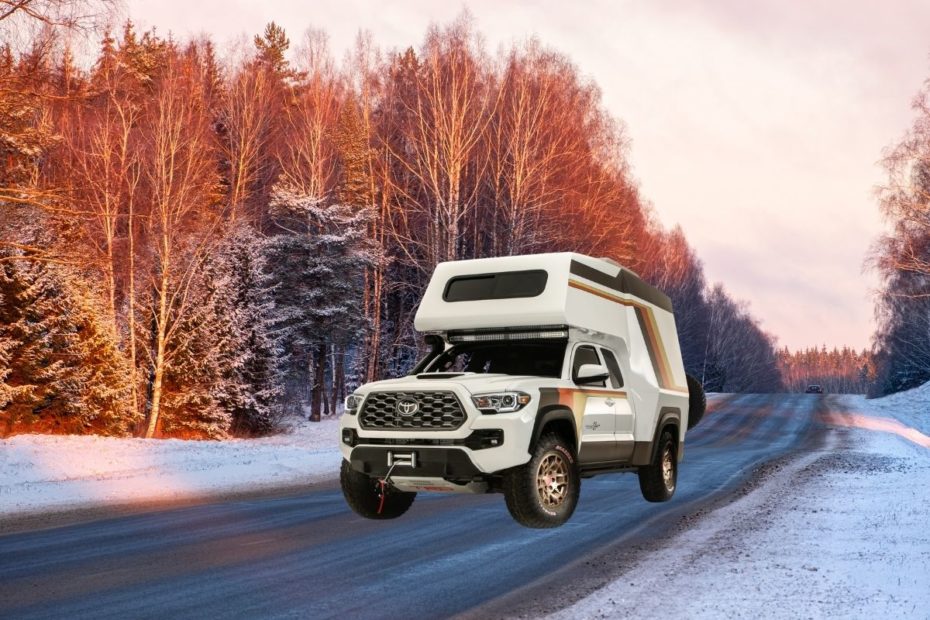The Toyota dealer near Anaheim is getting all nostalgic with new vehicles that look like vintage models. If you don’t know what we are talking about, you should know that the Japanese automaker has just revealed a custom-built lifted Tacoma camper that rides on 33-inch all-terrain tires, has a retro paint scheme, and a full bathroom and kitchen. No matter what you believe, this isn’t a vehicle you would find at Toyota dealer serving Anaheim, Ca because it is brand new but has a “blast from the past” vibe.
What Is Toyota’s New Camper?
This new camper, named the TacoZilla Tacoma Camper, is based on the most popular pickup among off-road enthusiasts – the Toyota Tacoma. Toyota outdid itself again at the latest SEMA Show by building another hardcore machine to boast the car company’s know-how. The TacoZilla Tacoma Camper is a retro-styled truck camper that has tiny house amenities with the mobility of a decent overlanding rig.
The car experts at Toyota dealer near Anaheim tell us precisely that the TacoZilla is based on a Tacoma TRD Sport, even though the Toyota Motorsports Garage team has altered the platform significantly. The Tacoma’s frame was not sufficient enough, so they produced the camper’s chassis in-house. Although creating a camper without a dedicated frame would have been possible, the team wanted the rear compartment to be sufficiently comfortable to accommodate almost six feet, tall people. Also, the truck’s suspension gives two extra inches of clearance compared to the standard units, reinforced by large 33-inch General Tire Grabber X3 all-terrain tires.
Tacozilla’s Retro Look
Suppose you have been a regular car shopper at Toyota dealer near Anaheim. In that case, you may remember the brand’s camper’s from the Seventies and Eighties, which Toyota Motorsports Garage drew inspiration from. The white paint embellished with yellow, orange, and bronze stripes hollers back to those times, while still having a stylish appearance on the modern truck’s facias.
Tacozilla’s Interior
When you step inside the camper, you are in for a treat. Toyota has put attention to detail to suit the design of Tacoma. This attention to detail carries on throughout the construction in areas such as the rear door, which needed over 100 hours of labor to finish. Enter through the door, and you will come face to face with conveniences such as teak flooring, a full kitchen with appliances, a full bathroom with a hot-water shower, and a 3D-printed dining table. With the table tucked away like a piece of wall art, the camper offers a lot of space for lounging or sleeping.
Although TacoZilla is just a SEMA Show concept, we won’t be surprised to see some homespun Tacozilla builds start to take shape. Because Overlanding is growing in popularity, Toyota may consider selling these vehicles directly from dealers in the near future.
What’s Overlanding?
Suppose you are wondering what overlanding is exactly. In that case, it is essentially a new approach to exploring the outdoors in the U.S. These past few years have witnessed a boom in vehicle-based exploration and created a strong following by off-the-grid enthusiasts. To give a hand to the cause, off-roading aftermarket brands and car manufacturers have realized overlanding’s increasing popularity and are broadening their stock to replicate. For this reason, there is now a whole industry assigned to overlanding in the U.S.
So, what exactly is overlanding? Well, as Wikipedia has summed it up in a nutshell, “Overlanding is self-reliant overland travel to remote destinations where the journey is the principal goal. Typically, but not exclusively, it is accomplished with mechanized off-road-capable transport (from bicycles to trucks) where the principal form of lodging is camping, often lasting for extended lengths of time (months to years) and spanning international boundaries.”
The Basics Of Overlanding
Overlanding has existed on other continents for decades before it jumped on the scene in America. In the long run, overlanding is a mix of remote travel, off-roading, and camping. Overlanding goes back to the early 1900s when Australia started building long-distance travel routes within the continent. Mainly used for trading farm animals, motorists used these trade routes to transport livestock to markets on foot. Sometime later, Overlanding had a different meaning and would become an outdoorsy activity influenced by road builder, pioneer, and surveyor Leonard “Len” Beadell in the 1940s.
Overlanding, which is very different from a camping trip to the Grand Canyon National Park, typically consists of long-distance travel to faraway locations that are not registered and where not many people have explored. Overlanding can consist of many aspects such as crawling on massive boulders, plodding in deep waters, trudging through mud, and sprinting across a dry lakebed. Other features that characterize Overlanding consist of, but are not limited to, adventure, independence, discovery, and survival.
However, try to understand that spending the weekend roasting marshmallows over a relaxing campfire, tackling obstacles, and vanquishing trails, even though it sounds fascinating, does not make the grade for Overlanding.
To really go Overlanding, you have to remove yourself off the grid and go off to the unknown for days, weeks, months, and even for years at a time, depending on your expedition. A person goes Overlanding to find something greater than themselves, not just for vacation purposes.
